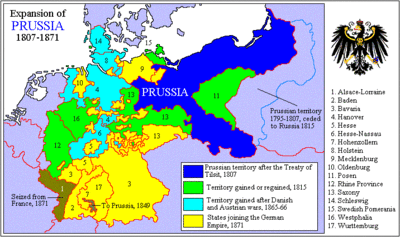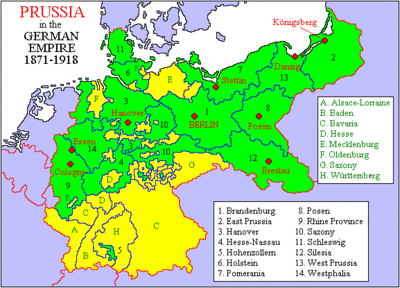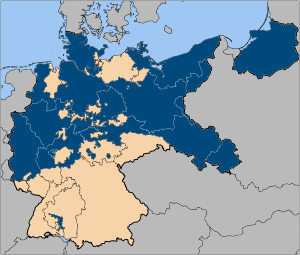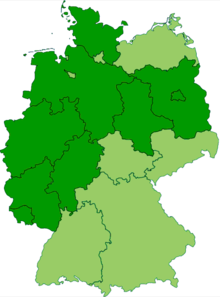- Provinces of Prussia
-
The Provinces of Prussia constituted the main administrative divisions of Prussia. Following the dissolution of the Holy Roman Empire in 1806 and the Congress of Vienna in 1815 the various princely states in Germany gained their nominal sovereignty, but the reunification process that culminated in the creation of the German Empire in 1871, produced a country that was constituted of several princely states and dominated by one of them, the Kingdom of Prussia. The Provinces of Prussia covered some 60 percent of the territory that was the German Empire. The appointed head of each province was known as Oberpräsident. Each province also had a provincial diet (Provinziallandtag in German). The provinces of Prussia were further subdivided into Regierungsbezirke.
Contents
Prussia in the German Confederation
 Provinces of Prussia in the German Confederation 1815-1871
Provinces of Prussia in the German Confederation 1815-1871
The German Confederation was created at the Congress of Vienna in 1815 and the Kingdom of Prussia was a member until its dissolution in 1866 following the Austro-Prussian War.
- Brandenburg
- Hohenzollern (Created from annexation of Hohenzollern-Hechingen and Hohenzollern-Sigmaringen in 1850)
- Pomerania
- Posen (Created from the Grand Duchy of Posen in 1848)
- Prussia (Created from the provinces East Prussia and West Prussia, 1824 - 1878)
- Rhine Province (Created from the Lower Rhine and Jülich-Cleves-Berg in 1822)
- Saxony
- Silesia
- Westphalia
- Hannover, since 1866
- Hessen-Nassau, since 1866
Prussia in the German Empire
 Provinces of Prussia in the German Empire 1871-1918
Provinces of Prussia in the German Empire 1871-1918
The outcome of the Austro-Prussian War put an end to the aspirations of a grand unified state consisting of the countries in both Germany and Austria. Instead the North German Confederation was created under Prussian leadership, and following the Franco-Prussian War the German Empire was proclaimed in 1871. The German Empire was dissolved in 1918 following World War I. From 1875 on the provinces were bodies combining regional home rule through representatives delegated from each rural and urban county (German: Landkreis and Stadtkreis), forming the provincial diet (German: Provinziallandtag with a 6 year term), which elected from its midst a head of this self-administration, the Landesdirektor (with a 6 to 12 year term), and a provincial government (German: Provinzialausschuss, provincial committee) as well as part of the superordinated overall Prussian royal administration, supervising - on a provincial range - the self-governing municipalities and counties as well as each governorate (German: Regierungsbezirk, mere supervising bodies of the Prussian government). For this purpose the respective Prussian minister of interior affairs appointed an upper president (German: Oberpräsident) to each province, who fulfilled his task with the help of a Prussian government-appointed provincial council (German: Provinzialrat).
- Berlin (On 1 April 1881 the city was disentangled from the province of Brandenburg. Consisting of the mere one city of Berlin its lord mayor (German: Oberbürgermeister) fulfilled in personal union the task of the Landesdirektor and the city council the role of the provincial committee. While the role of the upper president was taken by the Prussian government-appointed chief of police (German: Polizeipräsident in Berlin).[1])
- Brandenburg (from 1881 on without Berlin, but the provincial institutions continued to reside in Berlin)
- East Prussia (recreated by dividing the Province of Prussia in 1878)
- Hanover (constituted from the Kingdom of Hanover, annexed in 1866)
- Hesse-Nassau (constituted from the Free City of Frankfurt upon Main, Electorate of Hesse, and the Duchy of Nassau, annexed in 1866)
- Hohenzollern
- Pomerania
- Posen
- Rhine Province
- Saxony
- Schleswig-Holstein (Annexed in 1866, in 1876 the Duchy of Saxe-Lauenburg, prior a German state of its own, merged in)
- Silesia
- West Prussia (recreated by dividing the Province of Prussia in 1878)
- Westphalia
Prussia in the Weimar Republic
 Provinces of Prussia in the Weimar Republic, territorial situation as of 1922-1928
Provinces of Prussia in the Weimar Republic, territorial situation as of 1922-1928
 Map of current states of Germany that are completely or mostly situated inside the old borders of Imperial Germany’s Kingdom of Prussia
Map of current states of Germany that are completely or mostly situated inside the old borders of Imperial Germany’s Kingdom of Prussia
After the fall of the German Empire the Kingdom of Prussia was reconstituted with a republican government as the Free State of Prussia. It had to cede virtually all territory belonging to the provinces of Posen and West Prussia to the newly created state of Poland and the League of Nations mandate of the Free City of Danzig. Smaller areas had been ceded to Belgium (East Cantons, formerly Rhineland), Czechoslovakia (Hlučín Region, formerly Silesia), Denmark (South Jutland, formerly Schleswig-Holstein), the League of Nations mandate of the Memel Territory (formerly East Prussia), Poland (eastern Upper Silesia, formerly Prov. of Silesia), and the Mandatory Saar (League of Nations) (formerly Rhineland). Prussia and its provinces formally continued to exist even though political control was eventually taken over by the National Socialist German Workers Party following their rise to power in 1933. Both Prussia and Nazi Germany was finally dissolved following the end of World War II in 1945.
- Berlin (in 1920 the city was considerably extended (Prussian Greater Berlin Act) on the expense of Brandenburg)
- Brandenburg
- East Prussia
- Hanover (in 1921 Pyrmont, prior a district of the Free State of Waldeck-Pyrmont, merged in)
- Hesse-Nassau (in 1929 the Free State of Waldeck, prior a German state of its own, merged in)
- Hohenzollern
- Lower Silesia (Part of Silesia between 1938 and 1941)
- Pomerania
- Posen-West Prussia (Created in 1922 from the parts of the provinces Posen and West Prussia that had not been ceded to Poland, the province was dissolved in 1938 with its territory being mainly incorporated into Pomerania, and two exclaves into Brandenburg and Silesia.)
- Rhine Province
- Saxony
- Schleswig-Holstein
- Upper Silesia (Part of Silesia between 1938 and 1941)
- Westphalia
Notes
- ^ Cf. Meyers großes Konversations-Lexikon: 20 vols. – completely new ed. and ext. ed., Leipzig and Vienna: Bibliographisches Institut, 1903-08, here vol. 2, article 'Berlin', p 700. No ISBN
Categories:
Wikimedia Foundation. 2010.
